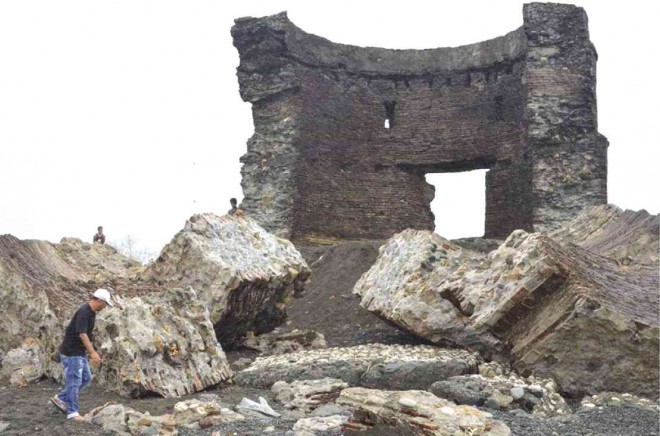
THE OTHER half of the Spanish-era watchtower, which stands on a stony beach in the village of Victoria in Luna, La Union province, crumbled as strong waves scoured the coastline when Typhoon “Lando” (international name: Koppu) battered northern Luzon this week. CONTRIBUTED PHOTO
DAGUPAN CITY—In the early morning of Tuesday, residents of Luna, La Union province, woke up to the nightmare they had been dreading for so long: Half of what was believed to be a 400-year-old watchtower called “baluarte” had collapsed.
The structure, built during the Spanish era and which put Luna on the tourism map, was a victim of Typhoon “Lando” (international name: Koppu) when it battered northern Luzon with up to 185 kilometers per hour winds and rain from Oct. 18-20.
Victor Marvin Marron, mayor of the town, said he doesn’t know what time half of the structure collapsed.
“When we went there at sunrise, we were greeted by the disheartening sight,” said Marron.
Until the collapse of half of the tower, the watchtower was leaning at a 20-degree angle, which engineers described in 2013 as dangerous for an old structure that is made of adobe and coral blocks and held together by lime and egg whites. It sits on the stony, scenic beach of Luna where residents collect colorful stones to sell.
The watchtower served as a fortress. It was used by Spanish colonizers to warn residents of pirates, according to historical accounts.
Half of it was unable to withstand Lando’s wrath. “Lando’s winds were so powerful that these generated strong waves that scoured the sand and stones under the baluarte,” the mayor said.
For years, the watchtower had been split in half almost right in the middle. With one half toppled, the other half defied the test of time and served as a memory of an era long gone.
The piles (concrete columns) that were used to prop the structure were no match for the giant waves that they were strewn around like match sticks. The gabion mattress (cages filled with rocks) spread around the structure also proved useless in protecting its foundation.
“Just when the baluarte has become known far and wide and became a tourism icon of the town, this happened,” Marron said.
While historical accounts have not established the structure’s actual age, whether it is 400 or 150 years old, Luna is determined to save it because it reminds the town of its history, Marron said.
He said the town government wants to protect the remaining structure by putting up warning signs to keep people away. It plans to reinforce it with a wall to prevent private collectors from “stealing pieces of fallen history,” he said.
Mary Jane Ortega, former San Fernando City mayor, who has been working for the watchtower’s preservation, said she had written the National Museum of the Philippines to ask if the structure can be restored.
AMH Phils Inc., a consultancy firm based in the University of the Philippines in Diliman, Quezon City, prepared a feasibility study in 2013 on how best to preserve the historical landmark, which faces the West Philippine Sea.
The group said a major typhoon, which could generate 10-meter-high storm surges, would shatter the watchtower.
“The surviving portion of baluarte still looks imposing, something like a gate to paradise,” Marron said. “We would continue to be proud of whatever is left of this historical structure and preserve it as long as we can,” he said.